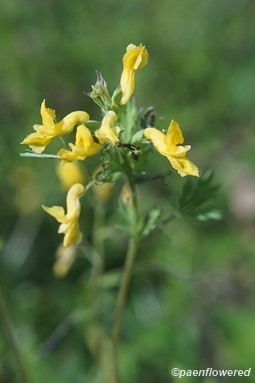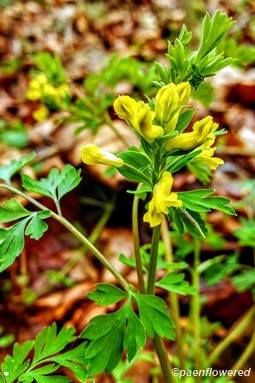Corydalis flavula
Corydalis flavula yellow fumewort
This native wildflower is found throughout Eastern United States, but only in southern New England. It is most common in a band from southern Pennsylvania to Virginia and west to Arkansas. Except for a group of counties up to Lake Erie in Western Pennsylvania, it is generally not considered present in the northern half of Pennsylvania.
The stems of the plant are initially erect, but it can then recline and can become a ground cover. Its natural habitat is lowland woods and slopes, primarily in lowlands. It is a pioneer species that requires disturbance of the soil (mostly by flooding, but also by wind or erosion) in order to germinate. This disturbance should moderately reduce, but not eliminate, the tree cover in order to permit it to obtain sufficient sunlight. As such, yellow fumewort is threatened by human activity that clears the forest for agriculture or development in these areas.
The elongated flowers are only ¼ inch long and yellow. They have four petals unequal in size and form. The uppermost petal has a spur. This species can be distinguished from similar flowers by noting the toothed crest on the upper petal of the flower. The flowers grow in clusters at the ends of the stalks. The leaves are compound in form and somewhat resemble those of squirrel corn and dutchman’s breeches. The fruit is an elongated capsule that looks like a pea pod. The seeds are black and shiny.
This species is usually a winter annual, though in the southern part of its range it may be biennial. The seeds mature by summer and germinate in late summer or autumn. They overwinter as seedlings and begin full growth in late winter or early in the spring. Most commonly they are in bloom from late March to early May. Population levels seem to fluctuate from year to year. It can be locally abundant, but populations seem to be scattered. Although the plant has been used in traditional herbal medicine, it contains toxic alkaloids and should not be consumed. It is also called the yellow harlequin corydalis or yellow or pale corydalis.
Habitat & Range
Occasional in moist woods, slopes, and edges of woods.
Mostly present in the south of the state.
| EMP: | FACU |
|---|---|
| NCNE: | FACU |
Phenology
Flowers April to May.
Characteristics
Height 6-16 inches
Plant Codes
S-rank: S5 (Secure)
G-rank: G5 (Secure)




Comments
Have you spotted this plant in your area? We'd love to hear about your experience! Share your comments or questions about the plant below. Comments are moderated before posting.